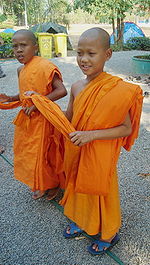
Samanera
Encyclopedia

Buddhism
Buddhism is a religion and philosophy encompassing a variety of traditions, beliefs and practices, largely based on teachings attributed to Siddhartha Gautama, commonly known as the Buddha . The Buddha lived and taught in the northeastern Indian subcontinent some time between the 6th and 4th...
context. The literal meaning is 'small samana
Shramana
A shramana is a wandering monk in certain ascetic traditions of ancient India including Jainism, Buddhism, and Ājīvikism. Famous śramaṇas include Mahavira and Gautama Buddha....
', that is, small renunciate where 'small' has the meaning of boy or girl. In the Vinaya
Vinaya
The Vinaya is the regulatory framework for the Buddhist monastic community, or sangha, based in the canonical texts called Vinaya Pitaka. The teachings of the Buddha, or Buddhadharma can be divided into two broad categories: 'Dharma' or doctrine, and 'Vinaya', or discipline...
monastic discipline, a man under the age of 20 cannot ordain as a bhikkhu
Bhikkhu
A Bhikkhu or Bhikṣu is an ordained male Buddhist monastic. A female monastic is called a Bhikkhuni Nepali: ). The life of Bhikkhus and Bhikkhunis is governed by a set of rules called the patimokkha within the vinaya's framework of monastic discipline...
, but can ordain as a samanera. The female counterpart of the samanera is the samaneri
Samaneri
A samaneri is a novice Buddhist nun, who lives according to the ten precepts. Male novices are called samaneras. A woman is to be ordained, according to Theravada tradition, by both a monk and a nun, first as a samaneri. After a year or at the age of 20, she will be ordained as a full bhikkhuni....
. Samaneras and samaneris keep the ten precepts as their code of behaviour, and are devoted to the Buddhist
Buddhism
Buddhism is a religion and philosophy encompassing a variety of traditions, beliefs and practices, largely based on teachings attributed to Siddhartha Gautama, commonly known as the Buddha . The Buddha lived and taught in the northeastern Indian subcontinent some time between the 6th and 4th...
religious life during a break from secular schooling, or in conjunction with it if devoted to formal ordination.
After a year or at the age of 20, a samanera will be considered for the higher Bhikkhu
Bhikkhu
A Bhikkhu or Bhikṣu is an ordained male Buddhist monastic. A female monastic is called a Bhikkhuni Nepali: ). The life of Bhikkhus and Bhikkhunis is governed by a set of rules called the patimokkha within the vinaya's framework of monastic discipline...
or Bhikkhuni
Bhikkhuni
A bhikkhuni or bhikṣuṇī is a fully ordained female Buddhist monastic. Male monastics are called bhikkhus. Both bhikkhunis and bhikkhus live by the vinaya...
ordination (Pali
Páli
- External links :* *...
: upasampada
Upasampada
Upasampadā literally means "approaching or nearing the ascetic tradition." In more common parlance it specifically refers to the rite of ordination by which one undertakes the Buddhist monastic life....
). Some monasteries will require people who want to ordain as a monk to be a novice for a set period of time, as a period of preparation and familiarization. Adults would normally wear the white robes of a Brahmin
Brahmin
Brahmin Brahman, Brahma and Brahmin.Brahman, Brahmin and Brahma have different meanings. Brahman refers to the Supreme Self...
, as do mae ji
Mae ji
Mae ji are Buddhist laywomen in Thailand occupying a position somewhere between that of an ordinary lay follower and an ordained monk. It is illegal for women to take ordination in Thailand. And they are expected to work essentially as maids to ordained monks, rather than receiving training and...
, who do not seek ordination.
The issue of ordination differs different for samaneras and samaneris.
See also
- OrdinationOrdinationIn general religious use, ordination is the process by which individuals are consecrated, that is, set apart as clergy to perform various religious rites and ceremonies. The process and ceremonies of ordination itself varies by religion and denomination. One who is in preparation for, or who is...
- Ordination process (Sangha)
- Poy Sang LongPoy Sang LongThe Poy Sang Long is a rite of passage ceremony among the Shan peoples, in Myanmar and in neighbouring Northern Thailand, undergone by boys at some point between seven and fourteen years of age...
- SamaneriSamaneriA samaneri is a novice Buddhist nun, who lives according to the ten precepts. Male novices are called samaneras. A woman is to be ordained, according to Theravada tradition, by both a monk and a nun, first as a samaneri. After a year or at the age of 20, she will be ordained as a full bhikkhuni....
- ShinbyuShinbyuShinbyu is the Burmese term for a novitiation ceremony in the tradition of Theravada Buddhism, referring to the celebrations marking the samanera ordination of a boy under the age of 20....
- SikkhamanaSikkhamanaIn Buddhism, a sikkhamānā is a female novice training to become a nun . In the Vinaya Pitaka's Cullavagga X.1.4, the Buddha prescribed that this training period is to be two years long, supervised by both a monk and a nun.A young woman should be ordained, according to Theravada tradition, by both...
- UnsuiUnsuiUnsui , or kōun ryūsui in full, is a term specific to Zen Buddhism which denotes a postulant awaiting acceptance into a monastery or a novice monk who has undertaken Zen training. Sometimes they will travel from monastery to monastery on a pilgrimage to find the appropriate Zen master to study with...
- AnagarikaAnagarikaIn Theravada Buddhism, an anagarika is a person who has given up most or all of his worldly possessions and responsibilities to commit fulltime to Buddhist practice. It is a midway status between monk and layperson where one takes on the Eight Precepts for the entire anagarika period, which could...

